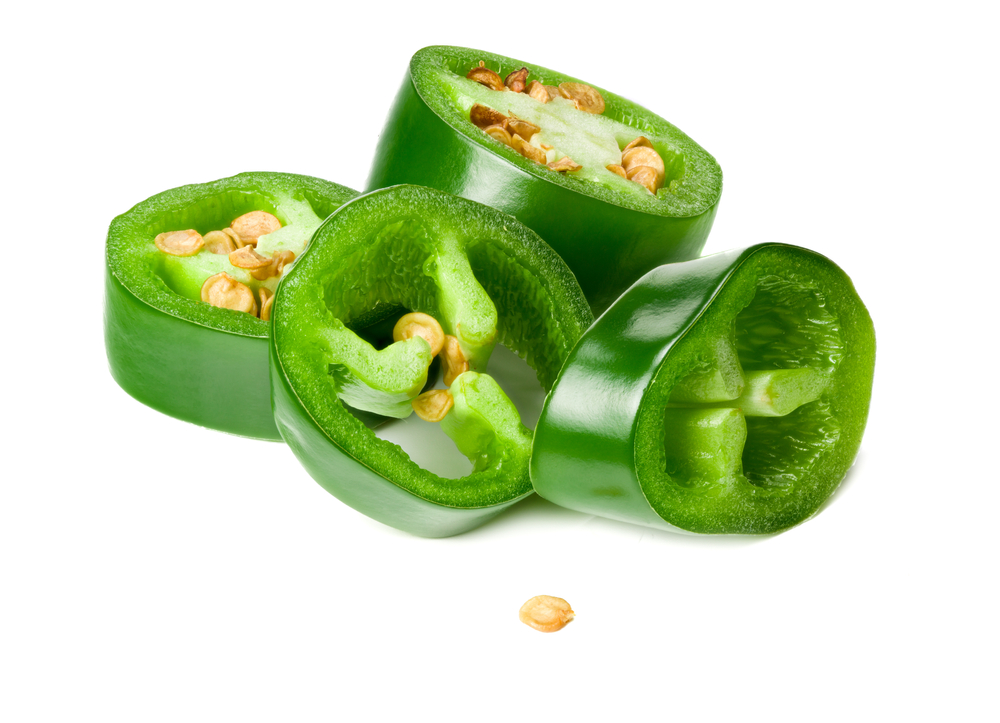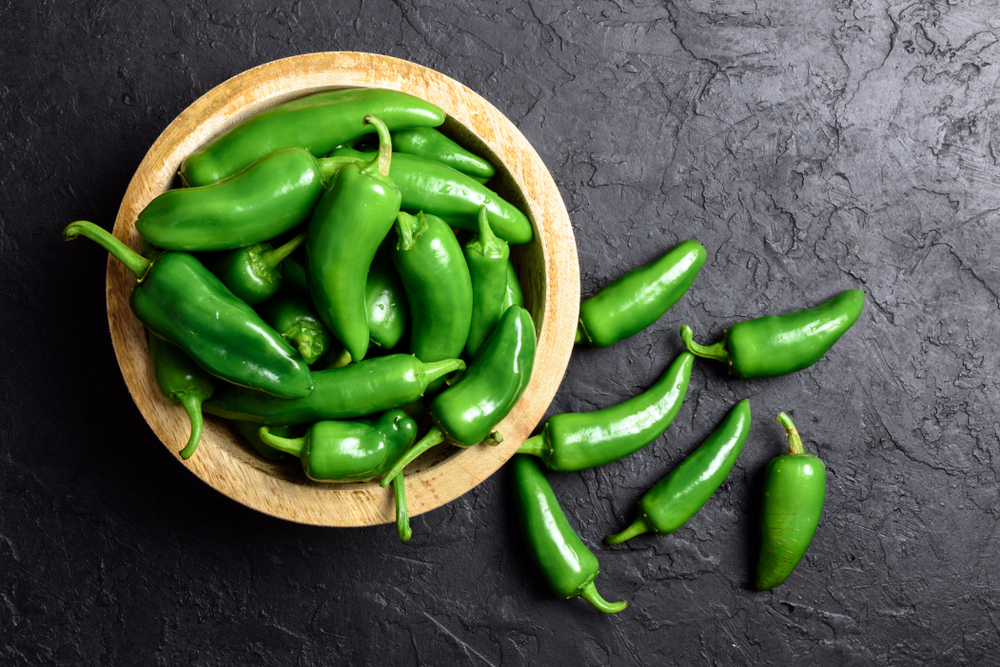Are you the one who’s always adding extra hot peppers to your sub at lunch? Are you always reaching for the extra-spicy salsa on the grocery store shelf? If this sounds like you, then you’ll be pleased to know that your penchant for a little kick in your meals is doing more for you than simply making you sweat. Jalapenos, those little green peppers ubiquitous with Mexican food, have a number of surprising health benefits. That’s right- move over kale, there’s a new superfood in town and it’s bringing the heat back to the nutrition world.
Jalapenos: A Nutrient-Packed Super Food

For starters, here is the macronutrient breakdown of Jalapeno peppers:
- Calories: 4
- Fat: 0 grams
- Carbohydrates: 1 gram
- Protein: 0.1 gram
- Fiber: 0.4 gram [1]
These spicy little peppers are high in vitamin A, vitamin C, and potassium, and also contain beta-carotene, which is an antioxidant that may help to prevent damage to your cells. They are rich in folate, vitamin K, and B vitamins [1]. With that said, what can Jalapenos really do?
Read More: 21 Incredibly Healthy and Affordable Foods
They May Help You Lose Weight

Jalapenos contain a little compound called capsaicin, which is what gives them their spicy kick [2]. You can eat it raw, cooked, as a dried powder, or even as a supplement [2]. Capsaicin can help you maintain a healthy weight, or even help you lose weight. How? It has to do with how your body stores fat.
You have two types of fat: white and brown. White fat is where you store excess energy (a.k.a.- calories) to use for later. The more calories you have stored, the more white fat you will have. Brown fat is filled with mitochondria. It is brown because it contains high levels of iron. It increases the number of calories you burn, which produces heat and warms your blood, helping your whole body to stay warm [3].
Due to its calorie-burning nature, having more brown fat can help you lose weight. There are a few ways you can activate the brown fat you have on your body, including standing out in the cold. If that doesn’t sound like a whole lot of fun to you, though, you can achieve a similar effect by eating hot peppers. Consuming capsaicin helps your body to activate brown fat tissue in the same way as cold temperatures [4]. Research has also found that people who consume capsaicinoids with their meals eat about 74 fewer calories than they normally would [5].
Hot Peppers May Help to Fight Cancer

If weight management was not enough to convince you to add some spice to your next meal, then consider this: capsaicin has been shown in lab studies to kill over forty types of cancer cells without harming your healthy cells [6]. This powerful compound can help stop cancer cells from growing and dividing, can slow down the formation of blood vessels around tumors, and can even stop cancer from spreading to other parts of your body [7]. More research needs to be done to understand how to effectively use capsaicin as a therapeutic intervention for cancer, but including more spicy peppers like jalapenos in your regular diet could benefit.
Jalapenos as a Pain Reliever

If you’re not one for spicy food and find consuming hot peppers to be a painful experience, this might sound ridiculous to you. But don’t worry- you don’t need to eat the pepper to reap the benefits here. When used externally, capsaicin temporarily blocks pain receptors wherever it is applied. You might feel a bit of a burn at first, but that quickly transitions into pain relief [8].
Before you go rubbing a jalapeno pepper all over your skin, slow down. Lotions and patches have been shown to help with shingles, diabetic nerve pain, arthritis, and even migraines when used in the form of a spray, but the science is still out as to whether or not eating jalapenos or applying them directly to the skin has the same effect [9]. Just remember, if you’re enjoying jalapenos and you suffer from migraines, avoid the pickled variety. These types of foods can sometimes trigger migraines in people due to their high tyramine content.
Prevent Stomach Ulcers

It was once falsely assumed that spicy foods were the cause of peptic ulcers. However, newer research has shown otherwise. There are a number of reasons why you might get a stomach ulcer. You could have an overgrowth of H.pylori bacteria in your stomach, too much stomach acid, or not enough blood flow to your stomach. If you take too many NSAID pain relievers (like Advil), or you are a heavy smoker, frequent drinker, or experience high levels of stress, you are also at risk for developing an ulcer [10].
Capsaicin could protect your stomach by reducing inflammation, and even help kill some of the H.pylori bacteria in your stomach [11]. While capsaicin may have some preventative effects when it comes to gastric ulcers, it’s best to proceed with caution when consuming spicy foods if you already have one.
Jalapenos are Good for Your Heart

Diabetes is one of the biggest risk factors for heart disease. Studies have found that people who eat five grams of capsaicin before a high-carb meal have lower levels of sugar in their blood [12]. While this research is preliminary, it could help people with diabetes control their blood sugar and prevent the spike in blood glucose levels that normally accompany a meal.
Hot Peppers Fight Infections

Humans have been using herbs and spices in cooking for decades to prevent food from spoiling. It comes as no surprise, then, that eating these same compounds could help fight infections in our bodies as well. Although much of this research has only been done in laboratory studies, and more research is needed to fully understand how they can be used as medicine, there is some evidence to suggest that capsaicin can help slow the growth of foodborne bacteria and yeasts, and can even help fight other types of infections like strep throat, tooth decay and chlamydia [9].
Add Some Spice to Your Life

You don’t need to start downing whole, raw jalapenos to get the benefits from capsaicin (in fact, we would advise against that). Getting some of that super-chemical is as simple as throwing a few slices of jalapenos on top of your next taco, or stirring them into a pot of chili. It’s not just in hot peppers either!
Try infusing some oil with chilis for a heart-healthy bread dip, or pickle them and throw them on top of a burger. Of course, adding them into salsa is a great way to add a little spice, and a little health, to your next chip-and-dip movie night.
Not great with spicy food? Start small- as you gradually start to introduce it into your diet you will build up a tolerance to how much spice you can handle. A little goes a long way, and you don’t need to eat an entire jar of pickled jalapenos to reap the rewards.
Disclaimer: This information is not intended to be a substitute for professional medical advice, diagnosis or treatment and is for information only. Always seek the advice of your physician or another qualified health provider with any questions about your medical condition and/or current medication. Do not disregard professional medical advice or delay seeking advice or treatment because of something you have read here.

Read More: 5 Ways to Keep Your Lymphatic System Healthy
Sources
- https://www.webmd.com/food-recipes/health-benefits-jalapenos#1
- https://www.healthlinkbc.ca/health-topics/ut1025spec
- https://www.webmd.com/diet/features/the-truth-about-fat
- https://www.ncbi.nlm.nih.gov/pubmed/24100669
- https://www.ncbi.nlm.nih.gov/pubmed/24246368
- https://www.ncbi.nlm.nih.gov/pubmed/22563012
- https://ar.iiarjournals.org/content/36/3/837.full.pdf
- https://www.ncbi.nlm.nih.gov/pubmed/21278678
- https://www.healthline.com/nutrition/jalapeno-health-benefits#pain-relief
- https://www.ncbi.nlm.nih.gov/pubmed/16621751
- https://www.ncbi.nlm.nih.gov/pubmed/17760719
- https://www.ncbi.nlm.nih.gov/pubmed/17760719

